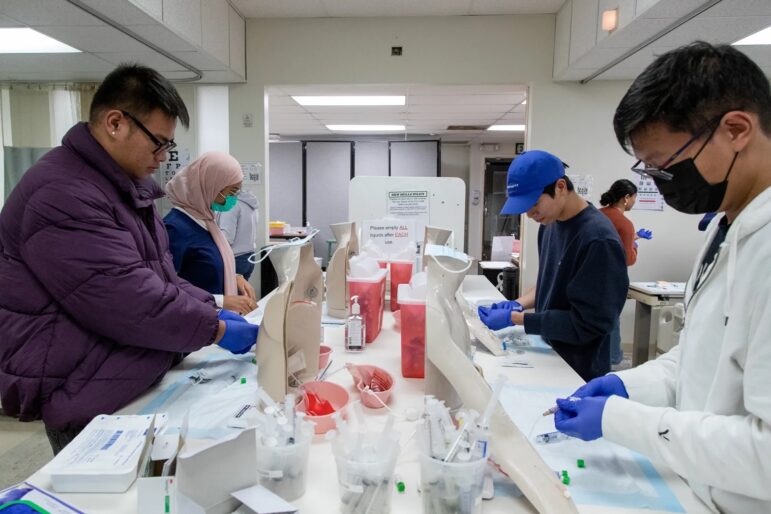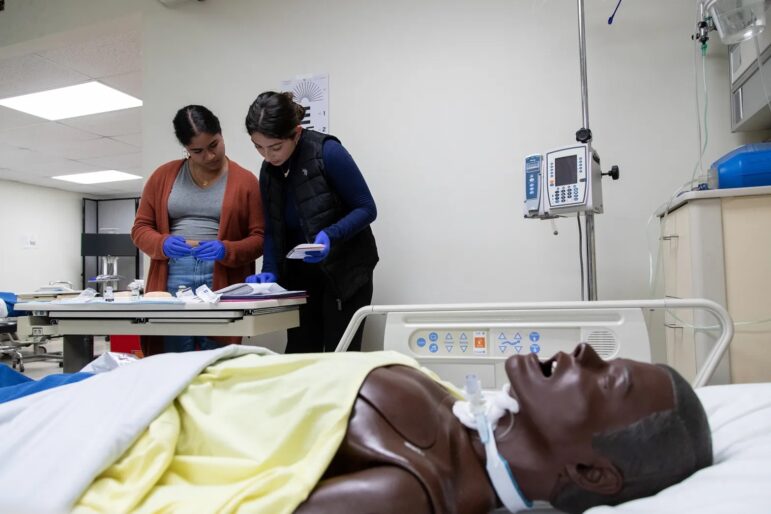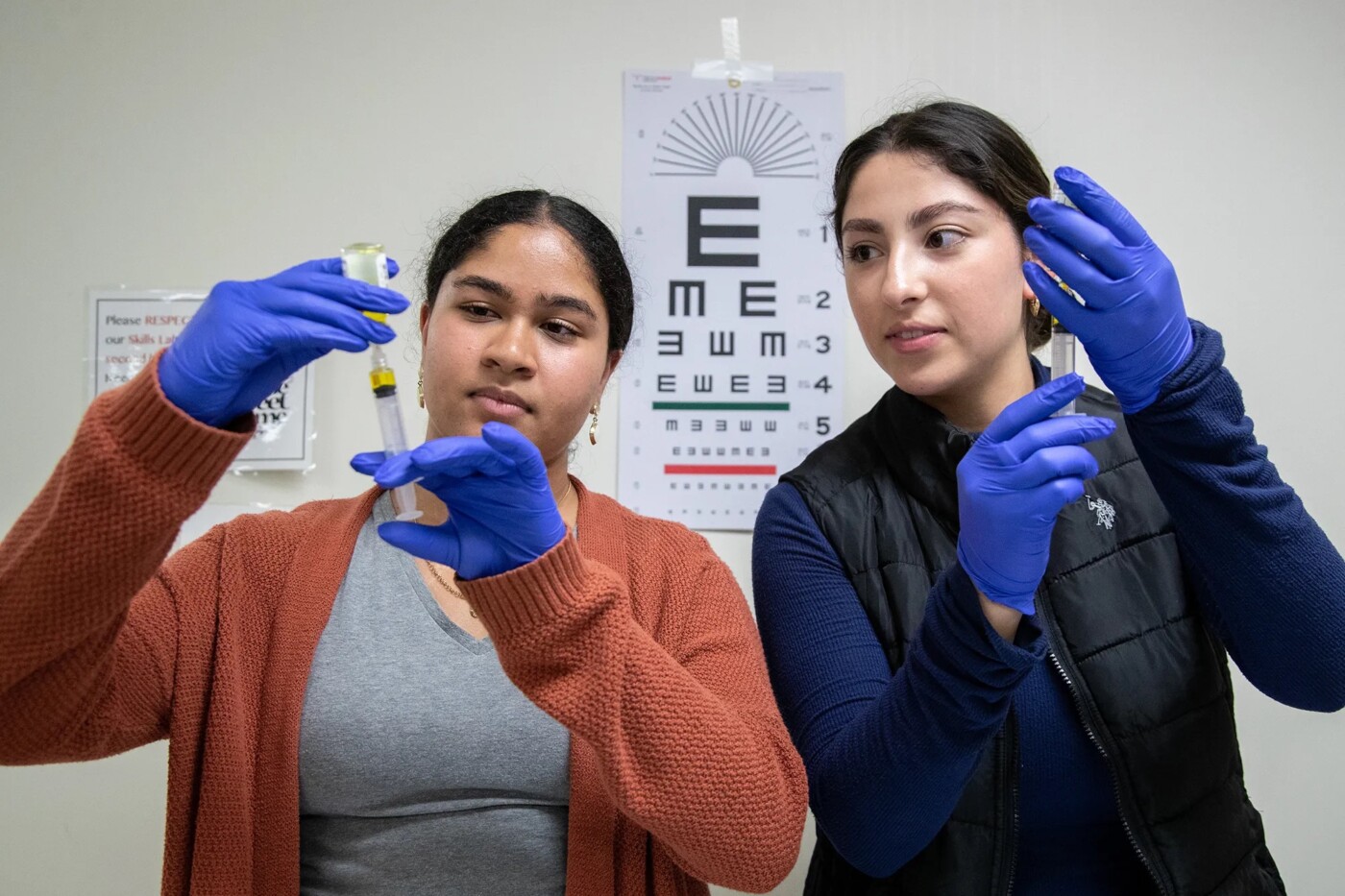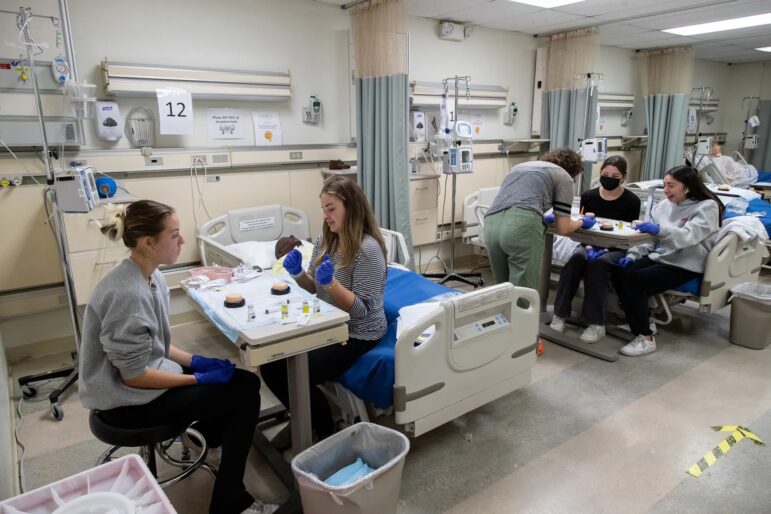For Julio Rivera, transferring from a local community college to a bachelor’s program in nursing was always a top priority. As someone who enjoyed helping others, nursing seemed like a natural career. While caring for an aunt with renal failure and Type 2 diabetes, a conversation with her solidified the belief that nursing was his calling.
“She said, ‘You have it. You can really tell that you care about people,’” Rivera said.
The pandemic put a pause on Rivera’s education as hospitals had difficulty accommodating student nurses. Rivera applied to public programs in San Bernardino County, but many of them were severely limiting clinical training, or not accepting new applicants at the time.
Instead, the 33-year-old chose an increasingly popular option — a private nursing program that would have a six-figure sticker price but guarantee him a timely degree. After finishing his pre-reqs, he transferred from Mt. San Antonio College to the Ontario campus of West Coast University.
Private nursing schools are teaching more students each year, filling in the gaps as California hospitals face increasing staffing shortages and public, four-year universities struggle to grow. According to the California Board of Registered Nursing, in 2021 nearly 64,300 students applied for just 16,600 spots in associate, bachelor’s, and master’s degree nursing programs. About 55% of those spots were at private institutions.
Prospective registered nurses have several pathways to their career. Associate degrees typically take two years to complete before students can take the licensing exam to become registered nurses. Bachelor’s degrees take more time with more intensive training, and increase the likelihood of career advancement and preferable hospital placement.
Although public and private programs each graduated about 6,700 nurses from all levels of degree programs in 2022, private colleges graduated three times the number of students with bachelor’s degrees as public schools. Public programs accounted for over five times as many associate degree completions than their private counterparts.
While public programs cost a fraction of private school tuition, the number of students graduating from private programs has doubled over the past 10 years while the number from public programs has remained stagnant. Students who seek to complete a bachelor’s of science in nursing program in California and advance their nursing career are faced with a difficult and unpredictable cost-benefit analysis: Apply to competitive UC and CSU public nursing programs with average tuition prices totaling about $39,000 or secure an education at a private nursing program for an average of $130,000.
Qualified applicants clamor for coveted bachelor’s program spots
Sima Sadaghiani, a nursing student at University of San Francisco, knew she wanted to be a nurse after spending time in the hospital with a sick family member during high school.
“I wanted something that would help me grow and develop and change other people’s lives,” Sadaghiani said. While in the hospital, she saw how nurses play a role beyond just administering medication, oftentimes providing mental support and educating patients about health and wellness.
When Sadaghiani applied to nursing school two years ago, she applied to private and public programs all over the state. She said the process of getting into a UC or CSU nursing program felt “all by chance,” even if an applicant had perfect grades and pre-career experiences. When she did not get into the public programs she applied to, she chose University of San Francisco because of its small class sizes, proximity to where she grew up in the Bay Area, and diversity of the patients in the area.

According to the state registered nursing board, the number of qualified applicants for bachelor’s programs has nearly tripled from 12,476 in 2012 to 35,474 in 2021, the last year for which this data is available. There was only space for about a quarter of the total qualified applicants statewide. The board serves as the licensing and regulatory body for all nurses in the state and is responsible for approving all expansions to nursing programs operating in California.
West Coast University boasts one of the largest nursing programs in the state, with 3,089 bachelor’s students across its three campuses in California, plus one in Texas and another in Florida. It costs around $146,000 to complete the school’s nursing bachelor’s degree.
Nearly 80% of students at West Coast University identified as being from an underrepresented racial or ethnic group, and 21% of their students are male, said Dean of Nursing Katie Kay. The school also serves more “non-traditional” students, offering courses throughout the summer and clinical training on weekends to give students many options to complete their degrees.
High cost leads to high return on investment
Private nursing programs can cost up to seven times as much as public programs.
Oge Okoye, a sophomore at the University of San Francisco, cast a wide net when applying to nursing school as a high school senior in Sacramento. She focused on colleges that have direct-entry, meaning if she got into the university, she would be guaranteed a spot in the school’s nursing program. The University of San Francisco offered her a four-year, full scholarship through their Black Scholars Program, which prepares Black nursing students to work in underserved communities.
“It came down to finances,” Okoye said. As one of three children, she wanted to alleviate the financial burden on her parents when it came to college. Without the scholarship, she could not have afforded the University of San Francisco’s $226,000 sticker price, one of the highest costs of attendance among private bachelor’s nursing programs. Her backup plan was attending Gonzaga University, a less expensive option, which she would have paid for with loans, scholarships, and financial aid.
College administrators say that the nursing field’s stability and high salaries mean students are able to pay off debt without defaulting on student loans.
“Our graduates are averaging positions after graduation (that pay) over $100,000 a year salary, so they’re well-positioned to pay back any loans that they were using to complete the program,” Kay said.
The average salary for a registered nurse in California as of May 2022 was $133,000 — the highest compensation for registered nurses in the country, according to the Bureau of Labor Statistics.
Martha Buck, a doctoral nursing student at University of San Diego, attended the University of Alabama for her bachelor’s degree before working eight years as an emergency room nurse in various hospitals around the country. Buck said she chose to continue schooling and attend the private doctoral program in San Diego — regardless of the $168,346 price tag — because of its reputable curriculum and resources dedicated to clinical training.
“After weighing the different options at different schools, I felt like I was getting more bang for my buck or a better value coming to USD,” Buck said. “Even though it was more expensive, the program seemed more robust.”
Buck said her eight-year nursing career has been fulfilling, but she chose to get her doctoral degree because she desired a more independent career as a nurse practitioner. Certified nurse practitioners can diagnose ailments, prescribe treatments, and conduct tests on patients while being paid $158,130 on average in California, according to the Bureau of Labor Statistics.
“I liked the idea of health care in general… I realized nursing is a really neat way to be around a ton of different people from different walks of life,” Buck said.
Despite the potential return on investment, the president of the California Nursing Association, Catherine Kennedy, said California could lose more potential nurses if admissions for public schools stagnate and private school prices remain high.
“I’ve talked to [prospective] nurses here in the state of California that can’t get into a program here,” said Kennedy, who has worked as a nurse for 42 years. “They end up going next door to Nevada, and they’re going to private schools, and it’s pretty pricey.”
Private programs expand despite challenges
To meet the demand for nursing education in California, 11 new private programs have opened in the past seven years — six of those between 2021 and 2022.
However, a shortage of nursing faculty has created another bottleneck in the field. Fewer clinical trainers and difficulties in attracting faculty have significantly impacted the training capacity of hospitals and universities. Private and public schools alike struggle to find the instructors needed to support and teach students.
“When I talk to clinical faculty, or I’m interviewing clinical faculty, and I tell them how much I pay, they’re like ‘I can make that much working a shift,’” said Eileen Fry-Bowers, the dean of the School of Nursing and Health Professions at the University of San Francisco.
The average yearly salary of a college nursing instructor in California is $104,000, which is $29,000 less than the average registered nurse salary, according to the Bureau of Labor Statistics.
Nursing instructors must have clinical training experience, an advanced nursing degree, and one year of experience teaching or assisting in a classroom to become a certified instructor through the state registered nursing board.
Fry-Bowers believes there needs to be more incentives for nurses to fill teaching positions. She said that increasing workforce development grants, adding more scholarships for advanced nursing degrees, and reconsidering the requirements for nursing faculty would all help to develop more faculty to teach students.
Trainer shortages in hospitals
In January this year, the state registered nursing board set the requirement for clinical training to 500 hours of direct patient care. This hands-on experience is guided by trained nurses to prepare future graduates to support patients in hospital settings. However, hospitals are already struggling with a nursing shortage, which means clinical trainers are in short supply as well.
Kimberly Dunker, dean of nursing at Pacific Union College — a private, Seventh-day Adventist college in Angwin in Napa County — said clinical trainer shortages have had significant impacts. With 848 students in the program, Pacific Union graduated 67% of their nursing students on time in 2021, lower than the 85% statewide average, according to the state registered nursing board.
“If you don’t have [trainers]…that are able to supervise those nurses in the hospital setting, it really causes a delay,” Dunker said.
Eleanor Eberhard, the chief operating officer and chief nursing executive at Sequoia Hospital, a small facility in Redwood City, says the hospitals can only support so many students. The location trains between 15 and 20 students each semester, with two or three instructors working with the students. Nurses at the hospital are paid to work as preceptors, experienced nurses who teach in clinical settings.
Nursing schools are finding “very creative” solutions to prepare faculty to teach classes and obtain enough clinical placements for their students, Fry-Bowers said. The administrative staff at the University of San Francisco work with hospitals, which determine available shifts for student nurse training, and then the staff have to find faculty who are available at that time to work with students.
“It’s a puzzle, and [all the pieces] need to fit together in order for us to deliver the product to our already enrolled students, let alone increase those numbers,” Fry-Bowers said.

Large programs like the University of San Francisco have over 100 clinical partners where students train, some as far as 60 miles away from campus.
“We’re competing with other schools,” said Tammy Valenta, program director for the Bachelor’s of Science in Nursing at Samuel Merritt University in Oakland. “Even though we don’t always get as many hours as we hoped for…our students graduate with at least 800, often more than that.”
Even with faculty and clinical placement shortages, Samuel Merritt University plans to support program growth by directing their training to more community-based, outpatient settings working with the elderly, mothers and children, or unhoused people.
West Coast University — like some other private programs — rotates students at different hospitals, private practices, emergency rooms, student health centers and various other clinical sites.
The future is expanding for nursing programs
Despite being outpaced by private program growth, some public nursing programs in California are expanding. Earlier this year, UC Davis received about $6 million and Riverside City College received about $2.7 million in federal funding from the U.S. Department of Labor to expand their programs. A $40 million gift from the William & Sue Gross Family Foundation will enable UC Irvine to double its faculty and enrollment over the next 10 years. In Huntington Beach, Golden West Community College’s School of Nursing received approval from the California Board of Registered Nursing to add 80 more students to its associate degree program. That will bring enrollment to 200 and add an option for students to also earn their bachelor’s degree in partnership with Cal State San Bernardino.
Nursing Association President Kennedy said that she believes expanding educational and professional pathways through community colleges and associate degrees could help to reduce the nursing shortage. This could potentially decrease pressure on private schools to continue enrolling with insufficient staff and address the financial burden of nursing programs on students.
“There’s a lot of barriers for kids that want to go into nursing at the community college level where it’s much cheaper,” Kennedy said. “Make (post-graduate employment) equitable for both programs so that we can get the nurses out of college and working.”


